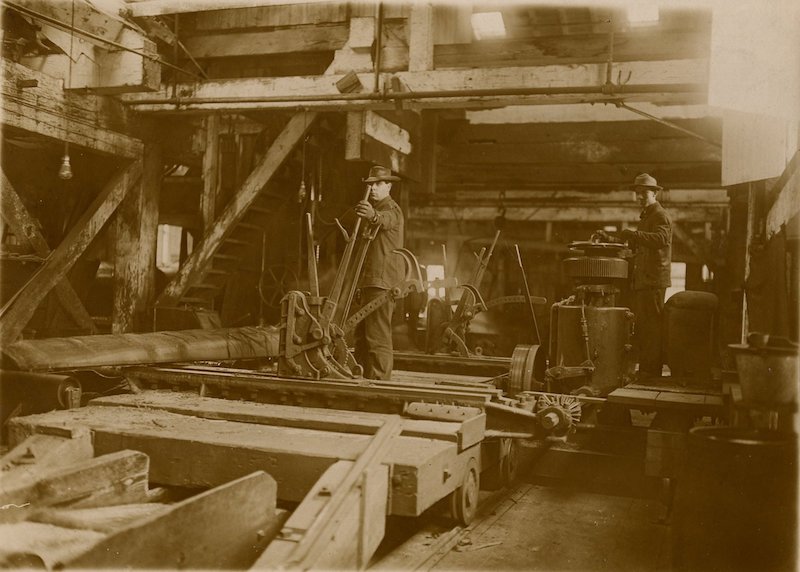Excerpt of a letter from Merna Brown Scott of Palo Alto, printed in the Mendocino Beacon on January 20, 1945. This letter was published two weeks after the Beacon reported that the Mendocino Mill, which had not operated since 1938, would be dismantled. Born in 1911, Merna, whose father worked at the mill, was the only child of Frank and Vernie Brown and grew up in the house on the northwest corner of Kasten and Ukiah streets.
With the dismantling of the mill on Big river, come memories of my childhood. The mill was a dominant feature in the lives of all who lived in the town of Mendocino. It lay south of the town about a quarter of a mile from the bay and the ocean.

Band Head at the Mendocino Lumber Mill. Frank Brown, setter, in the foreground and Bob Hayter on the right. (Gift of Merna Brown Scott)
Perhaps my earliest memory of the mill was the sound of the whistle. As I snuggled in my bed, the 6:30 am whistle would blow, and I would hear my father’s departure. Half an hour later the day’s work began with another blast from the whistle. The mill had other sounds besides the whistle. If there were a good stiff breeze in the mornings we could hear the engines, the hum of the saws, the trimmer, the re-saw and the rhythmical flap of boards on the sorting table. All these sounds blended into a composition almost melodic and were accentuated by the whine of the crane.
I remember well, my earliest visits to the mill. First, a peek into the fire-room with its big furnaces, then across the way to the room that housed the mighty engines. It was an awe-inspiring sight to a little girl for sure. It seemed a mass of huge wheels going around and around. And many times it was there that jovial Louie Larsen joked with us and we could scarcely hear above the din of motors. Upstairs we had to walk along a platform of slats that never failed to scare me, then past the room where the large saws were filed until finally we stood before the carriage and the saw. The back and forth motion of the carriage held us spellbound. Each trip meant another slice of redwood.
As we grew older our visits to the mill became less frequent, but the mill was always there making overtones in our gay existence. Hours on the white sands at the mouth of Big river meant that eyes and ears were filled with the sounds and sights of the mill. I can plainly see and hear it now – the red mill against a background of dark evergreens and azure sky – at our feet the green salty water and clean white sand covered with beached driftwood.
Sad were the days when the mill closed. The depression came to the redwood industry and our lives were effected in various ways. As long as the mill stood, even though idle, there was always a hope that someday the wheels would turn again. But now, the mill on Big river will only be a legend – a part of the great saga of the redwood country. I am grateful that I knew the mill in its most productive years.
Celebrate the 50th anniversary of Mendocino Historical Research Inc., now known as the Kelley House Museum. Meet founders Dorothy Bear and Beth Stebbins, who moved to Mendocino, fell in love with local history, then galvanized a community to establish a research center to preserve the town’s many stories and artifacts. On display are some of the earliest donations made to MHRI: census records from the 1860s, clothing from the Kelley family, the Ford family’s Bible, materials from Bear & Stebbins’ first exhibit “Mendocino Homes,” Anne Kendall Foote’s bespoke wallpaper reproductions, and photographs of the activists whose labor restored the house and whose contributions have supported the Kelley House over the years. 45007 Albion Street, Mendocino. Friday-Sunday, 11am – 3pm. Now until February 26.